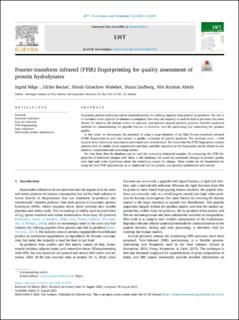Fourier-transform infrared (FTIR) fingerprinting for quality assessment of protein hydrolysates
Peer reviewed, Journal article
Published version
Permanent lenke
https://hdl.handle.net/11250/2783612Utgivelsesdato
2021Metadata
Vis full innførselSamlinger
- Artikler / Articles [1419]
- Publikasjoner fra CRIStin [2481]
Originalversjon
10.1016/j.lwt.2021.112339Sammendrag
Enzymatic protein hydrolysis can be used industrially for refining peptides from poultry by-products. The aim is to introduce these peptides for human consumption, but today the majority is used for feed or pet food. One main barrier for entering the human market is unknown and unstable peptide product qualities. Reliable analytical methods for characterising the peptide fraction is therefore vital for optimizing and controlling the product quality. In this work, we investigate the potential of using a large database of dry-film Fourier-transform Infrared (FTIR) fingerprints to gain new insight in quality variations of peptide products. The database cover >1300 samples from laboratory experiments performed over several years. We found that the FTIR fingerprints contain patterns that are stable across experiments and time, and that variations in the fingerprint can be related to raw material composition and processing factors. We also show that the database can be used for evaluating industrial samples. By comparing the FTIR fingerprints of industrial samples with those in the database, we could see systematic changes in product quality over time and make hypotheses about the underlying causes for change. These results lay the foundation for using dry-film FTIR spectroscopy as an industrial tool for product and process optimisation and control.
